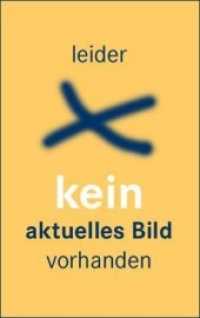- ホーム
- > 洋書
- > 英文書
- > History / World
Full Description
The archaeological study of quarries focuses mainly on the reconstruction of the extraction process, while rock-hewn spaces have often been approached from the point of view of architectural styles or art-history. Nevertheless, a holistic structural approach to the study of these spaces could allow a better understanding of the agency of those who carved the stone. Stone quarries and rock-cut sites have rarely been included in global studies of historical landscapes and few are the forums dedicated to the theoretical and methodological debate over the importance that these sites have for the understanding of past societies. To fill the gap, the proceedings volume aims at providing new data on sites located in Africa (Ethiopia, and Egypt), Europe (France, Croatia, Italy, Spain) and Asia (Turkey, Saudi Arabia) studied with a diachronic approach, as well as new theoretical reflections for the international debate on the archaeological investigation of rock-cut spaces and stone quarries. Two directions structure this volume: the analysis of the individual rock walls, considering the study of tool traces as a proxy for understanding the carving phases, as well as the analysis of the structure (site/quarry) as a whole, by contextualizing the results of the study of the single walls.The volume mainly targets researchers who are willing to discover quarries and rock-cut sites as aspects of the same mining phenomenon: places in which specific empirical and handcrafting knowledge related to stone working is expressed and conveyed, but also a wider audience that is interested in these peculiar and impressive sites.
Contents
Foreword
Gabriele Gattiglia (University of Pisa)
I. THEORETICAL AND METHODOLOGICAL CHALLENGES IN THE ARCHAEOLOGY OF QUARRIES AND ROCK-CUT SITES
Savoir-faire and Technical Environment: Rethinking the Emergence of Rock-cut Tombs in the Neolithic Mediterranean
Marie-Elise Porqueddu (The School of Advanced Hispanic and Iberian Studies, Casa de Velázquez)
What to Expect when you're Documenting and Excavating a Roman Quarry - Monte del Vescovo, Istria, Croatia
Katarina Šprem (Juraj Dobrila University of Pula)
Theorising Ancient Quarries: How Far Have We Come?
Christopher J. Lyes (School of Archaeology, University of Oxford)
When Quarry Waste Explains Tool Marks
Daniel Morleghem (Citeres-LAT, CNRS and University of Tours)
The Hand, the Stone and the Mind: Exploring the Agency of Rocks in Quarrying Techniques
Claudia Sciuto (University of Pisa)
II. CARVED SITES AND CARVED LANDSCAPES
How do Rock-cut Architectures Interact with the Landscape? The Example of Prehistoric Rock-cut Tombs in Ossi, Sardinia (Italy)
Guillaume Robin (University of Edinburgh)
A Study of Quartzite (Silicified Sandstone) Quarries in Egypt
Daniela Galazzo (Independent researcher)
First Reflections on the Structural Analysis of Rock-hewn Caves in Lalibela's Landscape, Ethiopia
Manon Routhiau (Traces, CNRS and University of Toulouse Jean Jaurès - Orient & Méditerranée, CNRS)
Quarrying, Carving and Shaping the Landscape. Stone Working at Dadan, Northwest Arabia, in the First Millennium BCE and Beyond
Thierry Grégor (University of Poitiers), Jérôme Rohmer (Orient & Méditerranée, CNRS) and Abdulrahman Alsuhaibani (King Saud University/Royal Commission for AlUla)
Underground and Open-pit Quarries in Polignano a Mare (Italy): a Preliminary Investigation
Germano Germano' (Scuola Superiore Meridionale in Naples)
III. ROCK-CUT SITES AND QUARRIES: CRAFTS AND SOCIETIES
The Left-handed and the Ambidextrous: Methodological Considerations by Way of the Excavation of Rock-cut Churches Over the Long Term
Anaïs Lamesa (French Institute for Anatolian Studies in Istanbul)
Qualifications of Craftsmen Who Dug Souterrains in France (10th-15th centuries) - Preliminary Results
Luc Stevens (French Society for Souterrains Studies)
The Technique of Extracting Building Stone by "Stone-walling and Back-filling" in Paris: an Innovation of the Late Middle Ages
Jean-Pierre Gély and Marc Viré† (LAMOP, CNRS and University of Paris Panthéon-Sorbonne)







